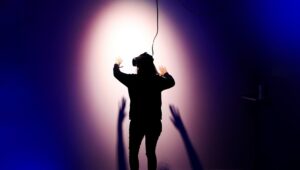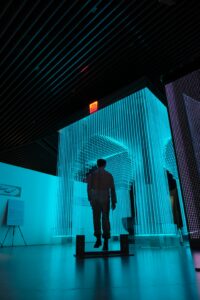
Do you remember when Pokémon Go took over Friday nights or those awesome scenes in superhero movies with hologram models of incredible gadgets? That’s what immersive design is all about.
The fancier way to explain it is that immersive design is the art and science of creating immersive experiences that engage the senses and the mind. The amazing thing about this industry is that it can be applied to almost anything—entertainment, education, healthcare, tourism, you name it.
Immersive design uses different technologies and mediums like VR, AR, 3D graphics and sound, haptics, and more.
But what do these terms mean?
Fear not, good reader; all essential terms will be explained shortly.

What is Immersive Design?
Immersive design creates digital environments that engage the user’s senses and emotions. It aims to provide a realistic and interactive experience that blurs the boundaries between the physical and virtual worlds.
There are two main types of immersive design.
- Immersive virtual reality uses a head-mounted device (HMD) or something similar to create a fully simulated environment that “replaces” the real one. In this reality, you can fully interact with your surroundings as if it’s real.
Examples of immersive virtual reality are video games, simulations, training, and therapy.
- Immersive augmented reality uses a smartphone, tablet, or smart glasses to overlay digital information or graphics on top of the real environment. You can see both real and virtual elements and interact with them.
Examples of immersive augmented reality include navigation, education, entertainment, and marketing.

Key Terminology for Immersive Design
360 Video
This technique captures a comprehensive 360-degree perspective of a scene. 360 video allows you to look around in any direction as if you were there. It can be viewed on a screen or in a VR headset.
3D (3-Dimensional)
This refers to an object or a scene (graphic) with depth, width, and height. 3D graphics are used to create realistic and immersive visuals.
AR (Augmented Reality)
AR refers to technology that overlays digital information or objects on top of the real world. AR alters your perception of reality by adding virtual elements that can interact with the physical environment.
CGI (Computer-Generated Imagery)
CGI creates images, animations, or effects using computer software. CGI can be used to create realistic or stylized visuals for immersive environments.
Eye Tracking
This technology tracks the movement and direction of your eyes. Eye tracking can control interfaces, enhance interactions, or measure attention and engagement in immersive designed environments.
FOV (Field of View)
This refers to the extent of the visible area you can see at any moment. FOV can be measured in degrees or as a percentage of the total area. FOV affects how immersive and realistic the experience feels.
Hand Tracking
This technology tracks the movement and position of your hands and fingers. Hand tracking can control interfaces and manipulate objects or gestures in immersive environments.
Head Tracking
Head tracking tracks the movement and position of your head. Head tracking can adjust the perspective, orientation, or sound of the immersive environment you experience based on your head movements.
Haptic Feedback
This technology creates tactile sensations through vibrations or forces. Haptic feedback makes the experience more real by simulating physical contact or interaction with virtual objects or environments.
Hybrid Reality
Combining VR and AR technologies creates a seamless blend of real and virtual worlds. Hybrid reality allows you to switch between different levels of immersion and interaction.
Presence
Presence is the feeling of being physically present in an immersive environment. It is influenced by realism, interactivity, agency, and embodiment. Presence enhances the emotional and cognitive impact of the experience.
Mixed Reality
A type of hybrid reality that merges real and virtual worlds to create new environments where physical and digital objects coexist and interact. Mixed reality can be seen as a spectrum that ranges from AR to VR.
Spatial Audio
Technology that creates 3D sounds that match your position and movement with virtual objects or environments. Spatial audio makes the experience feel more real by creating sound clues.
UX (User Experience)
A user’s overall experience when interacting with a product or a service. It includes usability, functionality, aesthetics, emotions, and satisfaction. UX is crucial as it determines how you feel and act in the immersive environment.
VR (Virtual Reality)
This technology creates a fully immersive and simulated environment that replaces the real world. VR transports you into a virtual world where you can freely navigate and interact using devices such as headsets, controllers, and sensors.
XR (Extended Reality)
This umbrella term encompasses all types of immersive design technologies that create or enhance reality. XR includes VR, AR, MR, hybrid reality, and other emerging forms of immersive media.

What does an Immersive Designer do?
These people have tons of skills! They are on top of their technical, creative, and artistic game. Add to that, immersive designers are curious and driven.
They are always exploring and experimenting with new ways to push the envelope in creating cutting-edge experiences for the end user. They also collaborate with other professionals like UX designers, graphic designers, and software developers to bring interactive designs to life.
Immersive designers aim to make users feel part of an interactive story, offering a unique and unforgettable experience.
If you want an immersive experience that’ll knock people’s socks right off, hit us up! Ascend Studios is your first port of call to amaze your consumers.
Photo by Stella Jacob on Unsplash
Photo by Sam Moghadam Khamseh on Unsplash